Nestled amidst the lush landscapes of Bali, Penglipuran Village stands as a testament to the enduring traditions and architectural heritage of the Balinese people. Its unique blend of cultural practices, sustainable tourism initiatives, and captivating village layout has made it a must-visit destination for travelers seeking an authentic glimpse into the heart of Bali.
The village’s traditional architectural style, characterized by its intricate bamboo structures and communal meeting place, the Bale Agung, reflects the deep connection between the villagers and their environment. Daily life in Penglipuran Village revolves around the Subak irrigation system, a centuries-old practice that ensures the village’s agricultural prosperity.
Village Overview
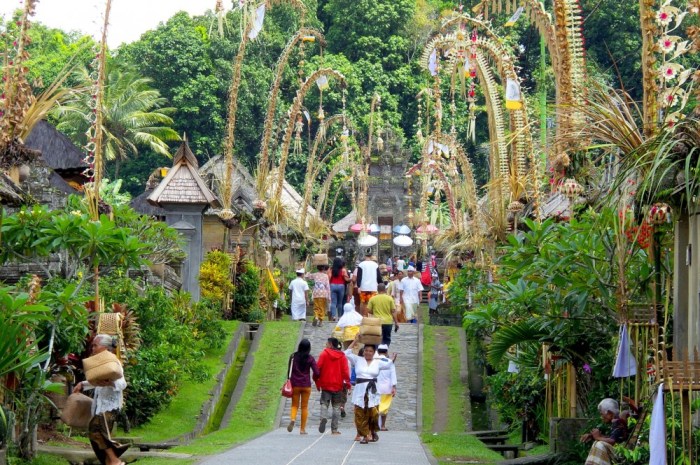
Nestled amidst the lush greenery of Bali’s Bangli Regency, Penglipuran Village is a captivating testament to traditional Balinese culture and architecture. Designated as one of Indonesia’s “Traditional Villages,” Penglipuran has preserved its centuries-old customs and practices, earning recognition as a UNESCO World Heritage Site in 2012.
Penglipuran Village is renowned for its unique “Tri Mandala” concept, which divides the village into three distinct zones: the sacred zone (Utama Mandala), the living zone (Madya Mandala), and the outer zone (Nista Mandala). Each zone serves a specific purpose and is meticulously maintained by the villagers.
Penglipuran Village, with its traditional architecture and serene atmosphere, is a testament to Bali’s rich cultural heritage. While its tranquility may be a far cry from the bustling metropolis of Singapore, the iconic marina bay sands singapore stands as a symbol of modern architectural prowess.
Yet, in the heart of Penglipuran Village, amidst the thatched roofs and lush greenery, lies a subtle reminder of the interconnectedness of the world, bridging the gap between tradition and modernity.
Unique Characteristics
Penglipuran Village is characterized by its distinctive bamboo architecture, with traditional houses adorned with intricate carvings and lush gardens. The village’s layout is carefully planned, with houses arranged in neat rows along narrow pathways. Bamboo fences line the streets, creating a serene and harmonious atmosphere.
Traditions
The villagers of Penglipuran uphold a strong sense of community and follow strict traditional customs. They practice “awig-awig,” a set of customary laws that govern village life and ensure the preservation of their heritage. The village’s unique traditions include the “megibung” communal dining practice, where villagers gather to share meals from a large tray.
Anecdotes
According to local legend, Penglipuran Village was founded by a priest named Kebo Iwa in the 12th century. It is believed that the village’s name, which means “the village of forgetting,” originated from the villagers’ ability to forget their worries and troubles amidst the tranquility of their surroundings.
Architectural Heritage: Penglipuran Village
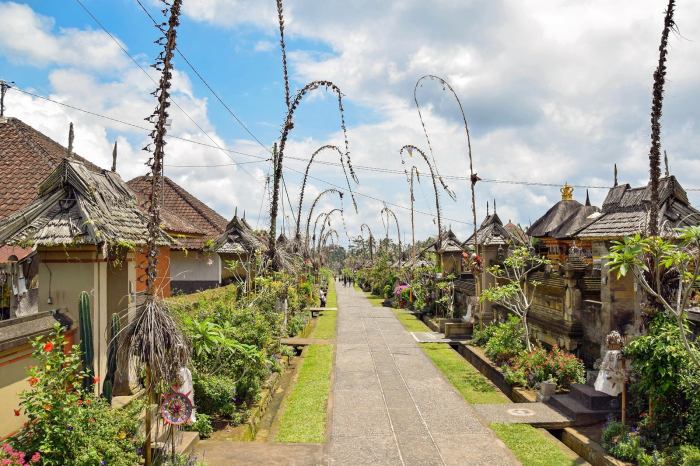
Penglipuran Village showcases a distinctive architectural style that reflects the local traditions and culture. The village’s houses and structures are primarily made of natural materials, such as bamboo, thatch, and wood. These materials provide a sustainable and eco-friendly approach to building, while also contributing to the village’s unique aesthetic.The use of bamboo in Penglipuran’s architecture is particularly significant.
Bamboo is a versatile and durable material that is widely used in traditional Balinese construction. It is strong, flexible, and resistant to pests, making it an ideal choice for building homes and other structures. The bamboo structures in Penglipuran are often adorned with intricate carvings and decorations, reflecting the artistic skills of the local craftsmen.
The Bale Agung
The Bale Agung is a communal meeting place located in the center of Penglipuran Village. It is a large, open-air pavilion that serves as a gathering space for villagers to discuss important matters, hold ceremonies, and socialize. The Bale Agung is a symbol of village unity and community spirit.
Its construction follows traditional Balinese architectural principles, with a thatched roof supported by wooden pillars and an open floor plan. The Bale Agung is a central part of village life in Penglipuran, and it plays a vital role in preserving the community’s traditions and customs.
Cultural Practices
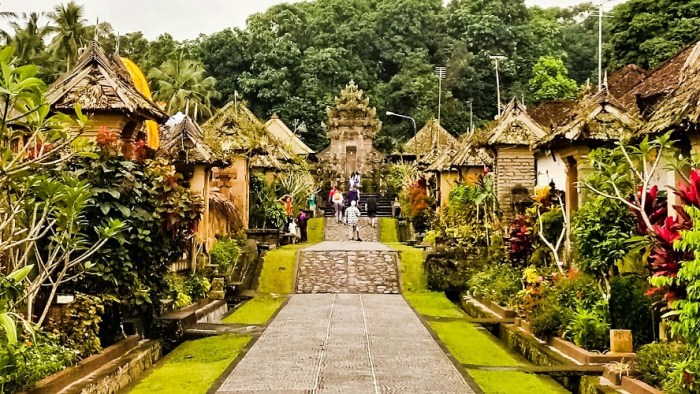
Penglipuran Village is renowned for its distinctive cultural practices that have been preserved for generations. The villagers lead a harmonious life guided by ancient traditions and customs.The Subak irrigation system plays a pivotal role in the village’s agricultural practices. This intricate network of canals and waterways ensures an equitable distribution of water, allowing the villagers to cultivate lush rice paddies.
The Subak system embodies the collective spirit of the community and is a testament to their agricultural expertise.
Traditional Ceremonies and Festivals, Penglipuran village
Penglipuran Village celebrates a rich array of traditional ceremonies and festivals throughout the year. These events hold deep cultural significance and serve to strengthen the bonds within the community.One of the most important ceremonies is the Galungan festival, which marks the victory of good over evil.
Penglipuran Village is a traditional Balinese village known for its unique architecture and cultural heritage. Its charm lies in its serene atmosphere, lush greenery, and well-preserved traditional houses. While Penglipuran Village offers a glimpse into the traditional Balinese way of life, those seeking a more vibrant and modern experience can head to Kuta Bali , a popular tourist destination known for its beaches, shopping, and nightlife.
After exploring the bustling streets of Kuta Bali, visitors can return to the tranquility of Penglipuran Village to appreciate its serene beauty and cultural significance.
During Galungan, the villagers erect towering bamboo poles adorned with offerings to honor their ancestors. Another significant festival is Kuningan, which is celebrated ten days after Galungan and signifies the return of the ancestral spirits to the heavens.
Sustainable Tourism
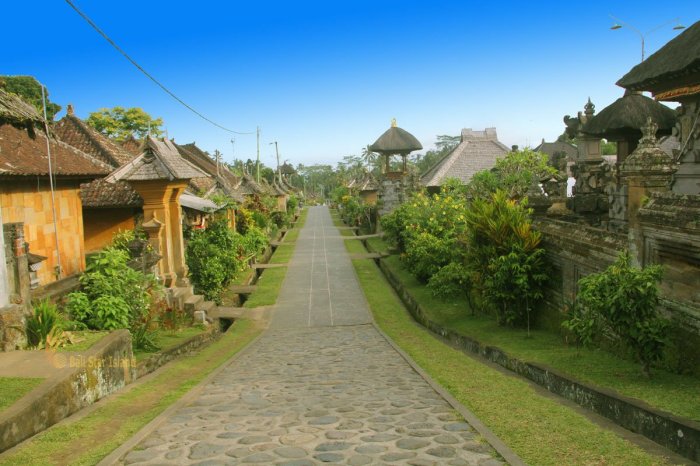
Penglipuran Village has become a model for sustainable tourism, embracing practices that preserve its environment and culture while benefiting its residents.
The villagers have implemented several initiatives to ensure the village’s sustainability, including:
Waste Management
- Comprehensive waste segregation and recycling program.
- Composting organic waste to create fertilizer for the village’s gardens.
- Ban on single-use plastics.
Water Conservation
- Rainwater harvesting system to collect and store rainwater for irrigation.
- Efficient water usage in households and public areas.
- Protection of natural water sources.
Energy Efficiency
- Use of solar panels to generate electricity.
- Energy-efficient lighting and appliances.
- Promotion of traditional building techniques that optimize natural ventilation and lighting.
Cultural Preservation
- Strict adherence to traditional architectural styles and building materials.
- Preservation of cultural practices, such as traditional ceremonies and dances.
- Promotion of local crafts and handicrafts.
Benefits of Sustainable Tourism
The implementation of sustainable tourism practices has brought numerous benefits to Penglipuran Village and its residents, including:
- Improved environmental quality and conservation of natural resources.
- Preservation of cultural heritage and traditions.
- Increased economic opportunities for local businesses.
- Enhanced quality of life for villagers.
- Positive recognition and increased tourism revenue.
Village Layout

Penglipuran Village is meticulously designed with a harmonious layout that reflects traditional Balinese principles. The village consists of a main road, known as Jalan Raya Penglipuran, which runs east-west through the center of the village. Off this main road, a network of smaller lanes and pathways connect the different areas of the village.
Penglipuran Village, a traditional Balinese village known for its unique architecture and cultural heritage, offers a serene escape from the bustling tourist areas. For a contrasting experience, consider venturing to the iconic rock bar bali , renowned for its breathtaking clifftop views and lively atmosphere.
Afterward, return to Penglipuran Village to immerse yourself once more in its tranquil ambiance and appreciate the harmony between nature and tradition.
The village is divided into three main sections: the north, south, and central areas. The north and south areas are primarily residential, with traditional Balinese houses lining the streets. The central area is the heart of the village and features the village temple, the Bale Banjar (community hall), and other important buildings.
Main Streets
The main streets in Penglipuran Village are:
- Jalan Raya Penglipuran: The main road that runs east-west through the center of the village.
- Jalan Melati: A smaller lane that runs parallel to Jalan Raya Penglipuran on the north side.
- Jalan Cempaka: A smaller lane that runs parallel to Jalan Raya Penglipuran on the south side.
Landmarks
Some of the notable landmarks in Penglipuran Village include:
- Pura Penataran Penglipuran: The main village temple.
- Bale Banjar Penglipuran: The community hall.
- Museum Penglipuran: A museum that showcases the history and culture of the village.
Points of Interest
Some of the points of interest in Penglipuran Village include:
| Landmark | Description | Location |
|---|---|---|
| Pura Penataran Penglipuran | The main village temple, built in the 14th century. | Central area |
| Bale Banjar Penglipuran | The community hall, used for meetings and ceremonies. | Central area |
| Museum Penglipuran | A museum that showcases the history and culture of the village. | Central area |
| Traditional Balinese houses | The village is lined with traditional Balinese houses, each with a unique design and courtyard. | North and south areas |
| Rice fields | The village is surrounded by lush rice fields, which provide a picturesque backdrop. | Outside the village |
Legend
- P: Pura (temple)
- B: Bale (community hall)
- M: Museum
- H: Traditional Balinese house
- R: Rice field
Ultimate Conclusion
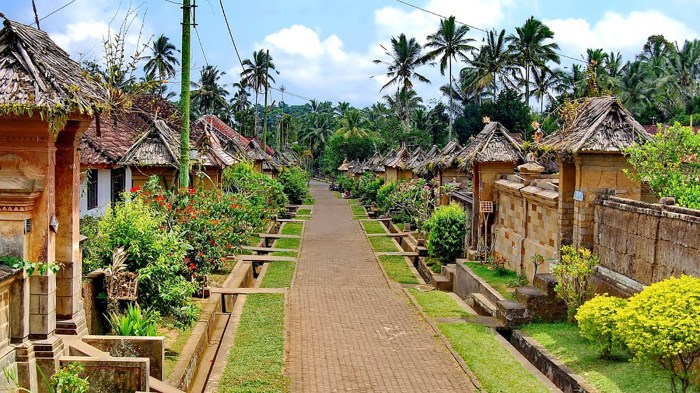
Penglipuran Village serves as a model for sustainable tourism, showcasing how communities can preserve their cultural heritage while embracing responsible tourism practices. Its success story highlights the importance of balancing economic development with the protection of the environment and traditional values.
As visitors delve into the rich tapestry of Penglipuran Village, they not only witness a living museum of Balinese culture but also gain a profound appreciation for the harmonious coexistence of tradition and modernity.
Clarifying Questions
What is the significance of the Bale Agung in Penglipuran Village?
The Bale Agung is the village’s communal meeting place, where important decisions are made, ceremonies are held, and the community gathers for social events.
How does the Subak irrigation system contribute to the village’s agricultural practices?
The Subak irrigation system ensures a fair distribution of water among the village’s rice paddies, allowing for optimal crop yields and agricultural sustainability.
What are some of the traditional ceremonies celebrated in Penglipuran Village?
Penglipuran Village celebrates various traditional ceremonies throughout the year, including the Galungan festival, which honors the ancestors, and the Kuningan festival, which marks the end of the Galungan period.